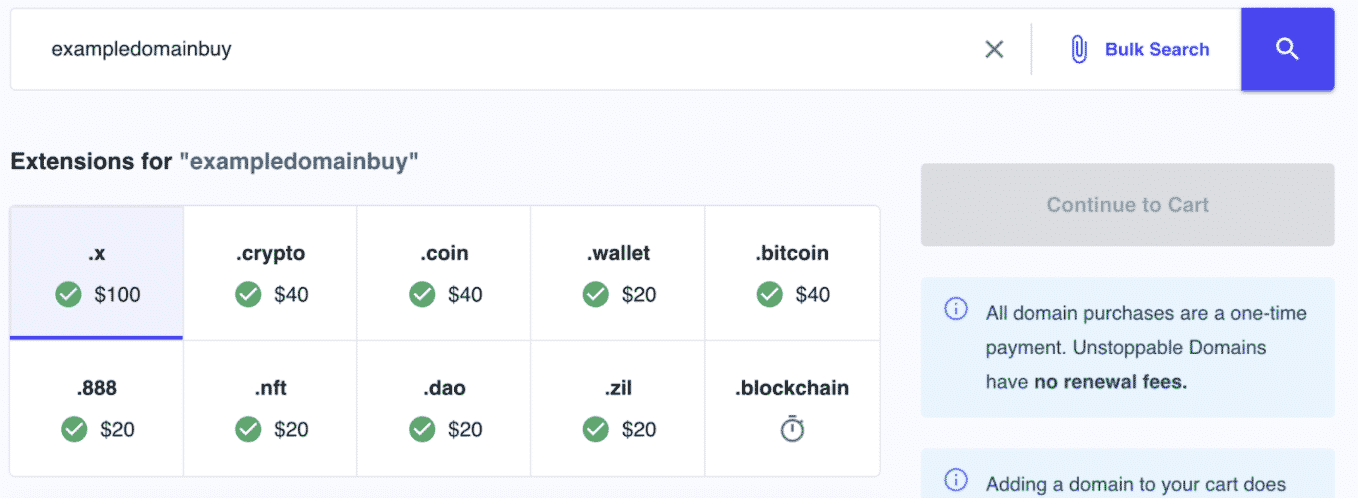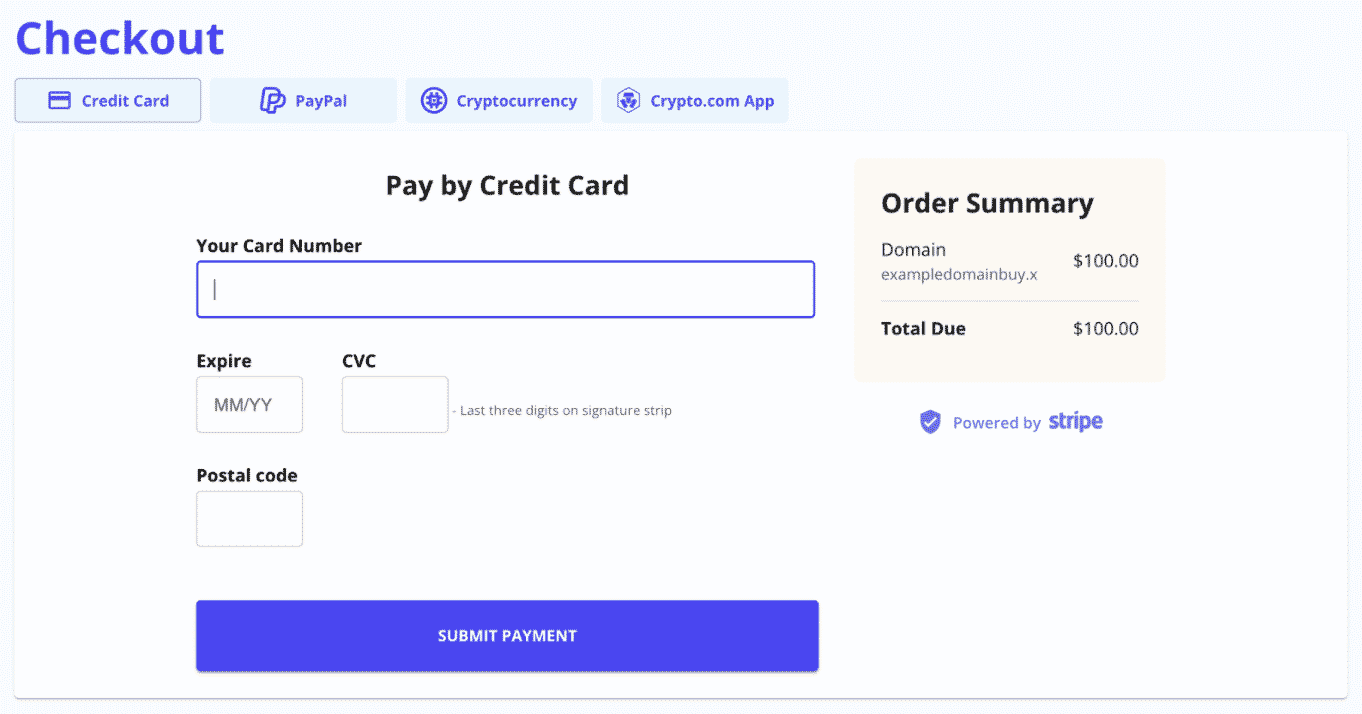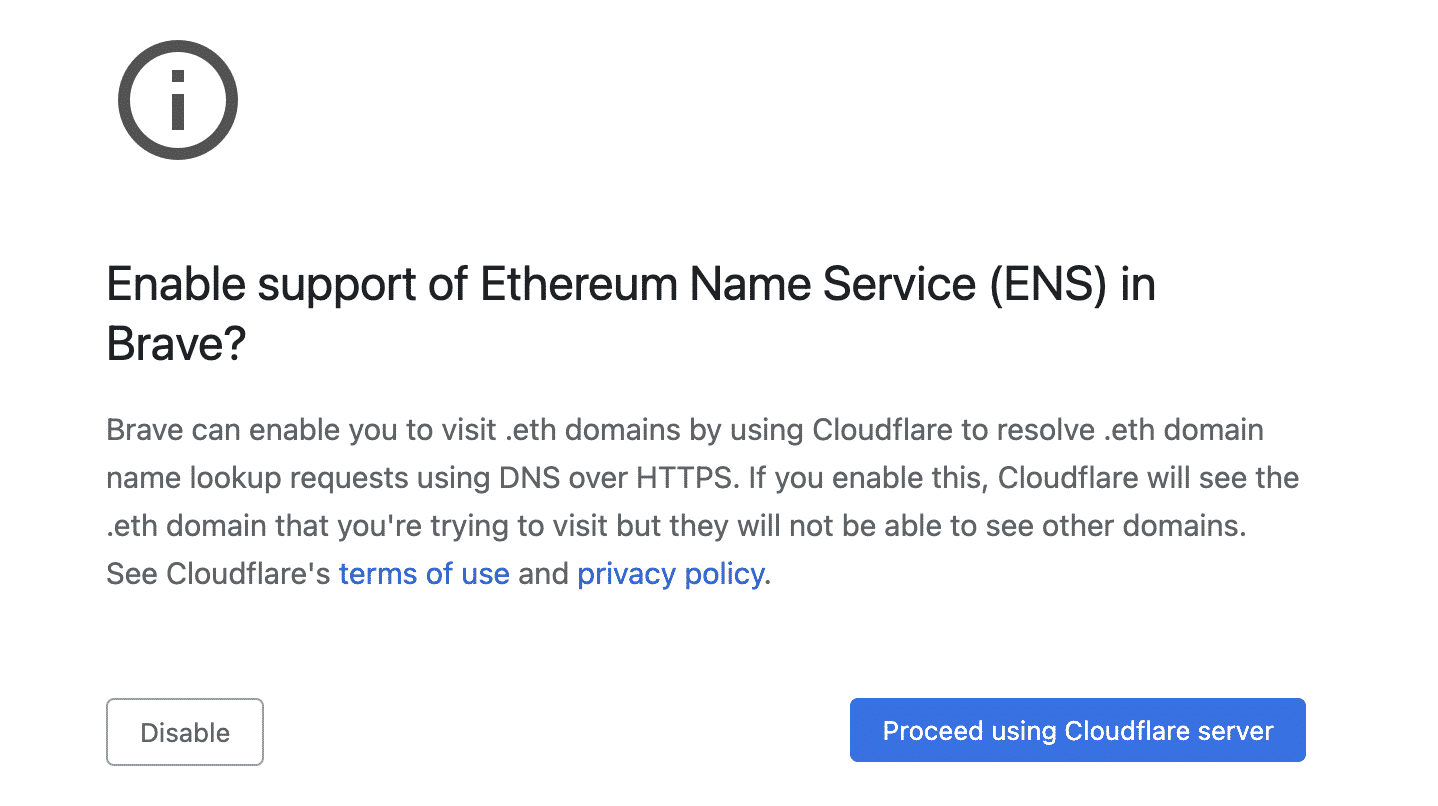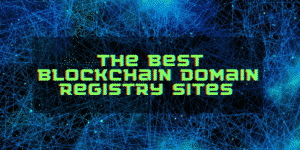- How Domain NFTs Work
- NFT Domains Explained: Putting Decentralized Domains Together
- How to Buy a Domain NFT
- Final Thoughts: Why Domain NFTs Are a Big Deal
A domain NFT is a unique domain represented by a single Non-Fungible Token (NFT) that functions as both a crypto wallet address as well as a standard website domain.
Historically, domains have been some of the most valuable pieces of digital real estate on the Internet:
- Business.com was purchased for $7.5 million in 1999, and, eight years later, sold for $345 million to RH Donnelly.
- LasVegas.com was sold for $90 million in 2005 to a Las Vegas travel agency.
- Voice.com was sold to Block.one, creators of the EOS cryptocurrency, for $30 Million in 2019.
- Crypto.com was bought by the crypto visa company then known as Monaco (MCO) in 2018 for an alleged $12 million.
If those numbers raise eyebrows, consider that those companies didn’t actually “purchase” the domain so much as “rent” the rights to it from a domain registry (we’ll get into all of this later). As soon as the technology to actually “own” something digital emerged, the tokenization of domains was inevitable.
It’s helpful to understand some NFT basics to get a better idea of how a domain NFT works; a Non-Fungible Token is a token that corresponds to a single unique asset, whether that be a picture of a Cool Cat, the title to a house, or in this case, a domain.
Web-2 Domains: .com, .org, .gov
Web-3 (NFT-based) Domains: .crypto, .x, .nft, .zil
Domain NFTs (also known as decentralized domains, crypto domains, or blockchain domains) offer several unique advantages to traditional domains.
Domain NFTs are also usually one-time purchases, in comparison to the annual renewal fee-based traditional Web-2 domain business models.
NFT domains are also 100% user-owned, meaning a centralized entity such as GoDaddy or Google Domains can’t censor or repossess your domain at their will.
What makes domain NFTs so interesting is that they can also function as cryptocurrency public addresses, meaning that the domain can send and receive other compatible cryptocurrencies and tokens as payment.
How Domain NFTs Work
There are two paths to take in this rabbit hole.
The first, which we’ll start out with, is basically all you need to know: NFT domains are crypto addresses that function as web addresses.
- You can buy them, sell them, and hodl them just like any other NFT.
- They double up as wallet addresses, so someone can send you (compatible) crypto directly to your NFT domain address, which looks something like mosky.eth
- They triple up as domain names, so you can visit a website like coincentral.crypto (don’t try it, doesn’t exist) and see the site’s intended content.
The second rabbit hole route is much longer, but way more fun. It’s what you could know– it’ll give you a more well-rounded understanding, but you’re functionally sound with the first route.
However, both require the groundwork basics of traditional domains.
The Prequel: Traditional, or “Web-2” Domains
Simply put, a domain name is the text that you type into a browser (Google Chrome) to reach a specific website (coincentral.com). In technical terms, it’s a string of text that corresponds to a numeric IP address.
There are billions of devices on the Internet at any given moment, and the IP (“Internet Protocol”) is a set of rules that allows devices to communicate over the Internet.
When you type in a domain name, like coincentral.com, into a web browser, you’re initiating a request to CoinCentral’s web server asking it to serve you content (our homepage content). This request contains your computer’s IP address. Once our web server receives the request, it sends a response back to your computer, and you see the content (or an error message.)
The Domain Name System (or DNS) is basically the phonebook of the Internet; it makes accessing websites a human-friendly endeavor– the actual IP address for coincentral.com is a complicated numerical IP address like 172.67.140.89.
Ok, let’s take a breather from all the definitions. If you think about it, it’s fascinating how everything just clicks together on this massive amazing Internet– this nitty-gritty stuff is actually really neat, but let’s get into the more functional stuff.
So, where do all these domain names come from? Who owns them? Well, there’s a whole hierarchy in place:
Most domain names are managed by domain registries, which are companies you’ve likely never heard of. For instance, a company named Verisign in Virginia is the authoritative registry for .com and .net domains among other Internet infrastructure assets– and they generate over $1 billion in revenue per year doing so.
Registries “manage” domains by maintaining the records of which individual domain belongs to who.
However, these registries are managed by a department called Internet Assigned Numbers Authority (IANA) within a global organization called Internet Corporation for Assigned Names and Numbers (ICANN). ICANN coordinates many of the processes and databases that keep the Web-2 Internet running.
With over 300 million registered domain names, registries have their hands full. So, Registries like Verisign will delegate the commercial sales of domain name registrations to registrars, such as GoDaddy. The registrars essentially act as salespeople on the front lines who get paid for every registration but also pay the register a fee– all of which is factored into the price charged to the end-user.
But wait, after I buy a domain, it’s mine, right?
Here’s the kicker– you don’t actually buy it, and it’s not actually yours. When you buy a Web-2 domain, you’re essentially “renting” it through a complicated back-end hierarchy for a maximum of ten years at a time. You can either extend your registration by paying an annual fee, but if you forget, the domain goes back on the market.
There have even been instances of less-than-reputable registrars preying on upcoming expired domain names by automatically buying the domains the moment they expire and then trying to sell them back to the original registrar (or open market) at a hefty price.
NFT Domains Explained: Putting Decentralized Domains Together
The problems Web-3 companies are looking to solve generally revolve around giving direct ownership to the end-user and away from a murky chain of command and intermediaries.
With the explosion of blockchain innovation in recent years came a myriad of applications, and Domain NFTs are one of the most exciting, but rarely talked about– granted, pictures of apes selling for millions make for better headlines.
Similar to DNS above, a company like ENS, or the Ethereum Name Service, turns a complicated crypto wallet address (0xb6060BFb836897EAECa521A7C2BE728D9BB5CE92) into something more human, like coincentral.eth.
Now, just like how you can send $20 to a complicated jumble of letters and numbers that is a crypto wallet address, you can send it to something like coincentral.eth.
Further, you can actually link your ENS domain to a website address (like in DNS), so when you enter something like coincentral.eth in Google Chrome, you’ll bring up a fully functional website that could be, in theory, identical to coincentral.com.
Unstoppable Domains, another crypto domain provider, offers a few distinct advantages:
-
- It’s also a hosting service: Think of it like a WP Engine that also hosts the domain.
- Multiple wallet addresses: coincentral.crypto, for example, could correspond to Ethereum, Bitcoin, Cardano, and Solana. ENS only works for Ethereum, and only offers .eth domains.
- It’s a one-time fee rather than annual payments: this way you actually “own” the domain rather than lease it.
How to Buy a Domain NFT
You may be familiar with the traditional process of buying a domain on a domain registrar like GoDaddy or Google Domains– you go on the domain registrar’s site, search a specific name, and if available, purchase it with a credit card or other accepted payment method.
For most intensive purposes, buying a domain NFT is very similar; behind the scenes is what is unique.
First, go to a Domain NFT marketplace (basically the same as a registrar) like Unstoppable Domains and search for your desired domain name.

Add your desired extension to your cart, and continue to checkout. Unstoppable Domains will require you to create an account. It also gives a variety of purchase options, including Web-2 options like credit card and PayPal, as well as Web-3 payments like cryptocurrency and through the Crypto.com app, which also serves as a wallet.
To finalize the purchase, you’d be basically “minting” the token that corresponds to the domain on the blockchain; this is what tells the blockchain that you own the domain. This process can take a few minutes pending network activity.

Once finished, you’re the 100% owner of this domain. Well, the token is the domain, so be sure to store it carefully. Marketplaces like Unstoppable Domains also function as the wallet for the domain, but you could theoretically put the domain NFT on a hardware wallet like a Ledger Nano S, software wallets like MetaMask, or even list it for sale on OpenSea.
Final Thoughts: Why Domain NFTs Are a Big Deal
NFT domains marry cryptocurrency, digital identity, and Internet infrastructure in a way that could be the early wave of the metaverse era of the new Internet.
For someone casually surfing the web, the NFT domains hardly register as even a cosmetic upgrade– going to a .crypto domain rather than a .com isn’t anything to necessarily force excitement over.
What goes on behind the scenes, however, is enough to make most technologists and entrepreneurs perk up to new possibilities.
For the first time ever, a decentralized domain can function as a wallet address with its own functional, decentralized financial infrastructure.
In one broad slash, domain NFTs eliminate the need for an esoteric hierarchy of an Internet infrastructure monopoly and payment processors like PayPal and Stripe that traditionally interface sites and their visitors for a percentage.
Domain NFTs, however, are not without their risks.
As with all cryptocurrency coins and tokens, domain NFTs need additional precautions that centralized domains don’t. Granted, an experienced hacker can just as easily break into your Google Domains account and steal your domains as they can on something like ENS or Unstoppable Domains if you don’t take preventative security measures. When a token is stolen, however, your recourse to recover it is basically zero.
There are a few limitations rooted in the novelty of domain NFTs worth considering.
For one, most popular browsers like Google Chrome don’t support domains like .crypto or .zil because they aren’t standard. Why? The people who run ICANN aren’t necessarily incentivized to support domains like .crypto or .zil, since they receive a portion of sales from traditional web-2 domains like .com or .org.
New, crypto-friendly browsers like Brave support NFT domains, but there are still more steps involved than the natural web surfing process.

Granted, the sudden velocity in crypto is tricky for most people to wrap their heads around, and an organization as impactful as running a pillar of the Internet understandably and methodically moves slowly.
The “decentralized internet” involves re-inventing, or at least re-thinking, that variety of modular pieces that make up the amalgam of interconnected protocols and software that we call the Internet– and domain NFTs are just one piece of the puzzle.
Never Miss Another Opportunity! Get hand selected news & info from our Crypto Experts so you can make educated, informed decisions that directly affect your crypto profits. Subscribe to CoinCentral free newsletter now.










